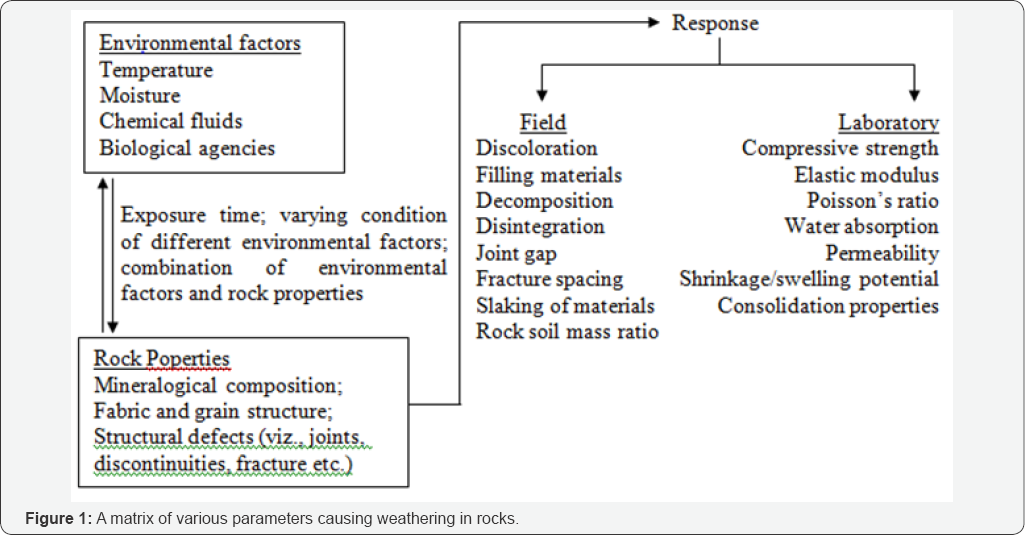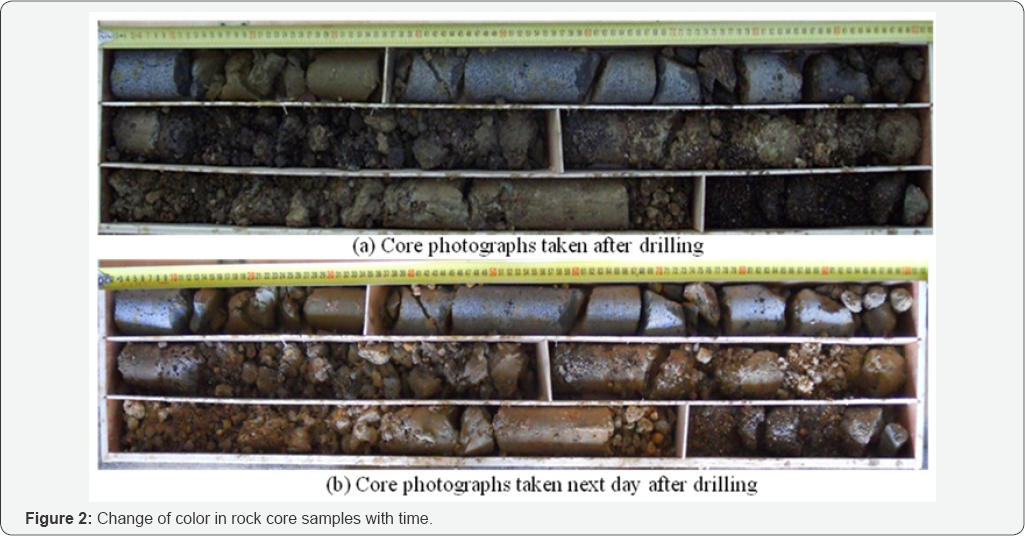Classification of Weathering in Rocks and Its Engineering Implications- Juniper Publishers
Juniper Publishers- Journal of Civil Engineering
Abstract
A critical review on the description and
classification of weathering in rocks has been presented in this paper.
This paper starts with a brief description on several factors causing
weathering in rocks followed by the weathering mechanism and the
description of weathering in rocks. A review of existing codes and
guidelines on weathering and its implications to describe the
engineering properties of rocks has been presented. From the point of
view that weathering process modify the mass engineering properties of
rocks which are quite unpredictable, this type of review work becomes
necessary. The present paper forms a useful source of information for
geologists and geotechnical engineers working on weathered rocks.
Keywords: Rock; Weathering; Classification; Guidelines; Engineering properties
Introduction
Weathering of rocks is a purely subjective term and is defined differently by different authors [1-4].
However, weathering in general is the process which brings about
several changes to the properties of rock mass due to its exposure to
changing environmental (physical, chemical and biological) conditions
and hence from the engineering point of view, grading of weathering
becomes very important. The alteration in the engineering properties of
rocks due to weathering may occur at the material scale (rock strength,
swelling potential, slaking index, compressibility, consolidation
characteristics etc.) and/or mass scale (discontinuities, fracture,
joint, settlement, permeability etc.), as reported in the literature [4-12].
Moreover, behavior of the weathered rocks depends upon the
environmental conditions, which it is further exposed to. For example,
weathered rocks in dry condition may swell or start disintegrating, when
coming in contact with water [13]. Similarly, different applications place emphasis on different attributes of the weathered rocks [14].
When constructing a building on weathered rocks, the engineer will be
interested more on its bearing capacity; whereas in case of slopes and
embankments he is more concerned with changes in permeability as a
result of weathering [15].
However, grading weathered rocks is a very difficult task and as a
result, the modification in various engineering properties of a
weathered rock is quite unpredictable and can’t follow any calculation
technique [4,16].
In addition, engineering may expose the rock mass to a new environment
and weathering may continue even after the construction has been over.
Efforts have been made by the researchers, engineers and geologists to
classify weathered rocks and its effects on various engineering
properties of rock mass. Moreover, codes and guidelines have been
formulated by the individuals (Table 1) and the international societies like International Society for Rock Mechanics [17]
and the Engineering Group of Geological Society Working Party. In this
paper, a review on various aspects of these guidelines and its
engineering implications has been highlighted.
Weathering of Rocks
Weathering in rocks is a very complex phenomenon that can be presented in a matrix form in (Figure 1).
It is not only the environmental conditions and the rock properties on
which the rate of weathering will depend but also the combination of
these factors, duration of exposure and the types of environmental
cycles (like wetting-drying, freeze-thaw etc.) that matters the most.
Moreover, it is the distribution and concentration of the
weather-resistant (e.g., quartz, feldspar etc.) and weather prone
minerals (e.g., biotitic, muscovite, hornblende etc.), that will affect
the grade of weathering [4,18-20].
In spite of these limitations, some of the researchers [16,2023]
have tried to correlate the rate of weathering through various
laboratory tests including X-ray diffraction (XRD) analysis; study of
minerals using Scanning electron microscope (SEM); measurement of
specific surface area (SSA), total cation exchange capacity (TCEC),
type of exchangeable cations and the pH value. These relationships are
very helpful for understanding the weathering mechanism in different
types of rocks. For example, weathering due to temperature is more on
dark rocks such as basalt but is less on white rocks like chalk [4]. On the other hand, weathering due to the effects of chemical fluids will be more on chalks than basalt.

Rocks of sedimentary and metamorphic origin (such as
clay shale's, poorly to moderately cemented sandstones, marl, and
anhydrite) are very moisture-sensitive and hence get weathered due to
reaction with water [14].
Basic and ultra basic igneous rocks, metamorphic rocks, limestone,
sandstone and mudshale, which contain plenty of silicate minerals,
easily convert into clay minerals such as montmorillonite, illite and
kaolinite through oxidation and reduction, hydration and dehydration,
ion exchange and leaching process [23]. Higgs [24]
has reported that igneous rocks with fine-grain sizes are more weather
resistant as compared to the coarse-grained types. Moreover, the
deterioration in some of the rocks like basalt increase significantly
due to the presence of secondary minerals which itself are product of
weathering of the fresh rocks [13,24,25,].

Description of weathering in rocks
Due to the effect of weathering, there occurs an
overall change in the engineering properties of rock mass. Hence, from
the engineering point of view, it becomes very important to classify the
weathering state of a rock mass. Various researchers, engineers and
geologists [4,6,12,16,26-32] have tried to do so in the past (Table 1).
It might be easy to understand the mechanism or process of weathering
in rocks through various laboratory tests, but very difficult to
quantify it. As mentioned earlier, weathering is a purely subject term
and there is no such calculation technique or laboratory tests
available, that can quantify the amount of weathering in rock mass.
Moreover, depending upon the types of engineering works, the rock mass
will be further exposed to weathering that can't be predicted. With
these limitations, different classifications for different sets of
environmental and rock conditions have been made.
However, it is observed that the descriptive terms
used for classifying weathered rocks are purely subjective. For example,
the color seen by one person will depend on the type of light source,
the background, the size of the object and the colors that have been
seen immediately before [14].
Moreover, many times it has been seen that there is a mismatch of these
descriptive terms (e.g. colors, decomposition, disintegration,
discontinuities, fracture spacing etc.) in the core logs and core
photographs due to their subjective in nature. The color of the rock
samples just or nearly after drilling will vary from that taken after
few hours depending upon the weather condition on site as shown in (Figure 2).

The concept of soil rock mass ratio [27,28] seems to be a better option to quantify the grade of weathering. Some of the researchers [33]
have tried to gauge rate of weathering in relation with specific
secondary mineral formation with the help of 14C methods. However, the
soil mass ratio will again depends upon the friability or slaking nature
of the rock mass and the environmental conditions to which it is
further exposed to. Interestingly, most of the classification systems
are based upon the changes in index properties of the weathered rock
mass. A very few attempts [11]
have been made to relate weathered rocks with its engineering
properties. It can be mentioned here that some of the field test results
like standard penetration test (SPT) blow count and the shear and
compression wave velocities can precisely represent the weathering state
in different rock mass. Donald et al. [19]
suggested that the percentage of core recovery is an indication of
soundness and degree of weathering of rock. Hence it is very important
that relative measurements of rock quality is made by comparing ratios
of field values of compression or shear wave velocities to laboratory
values. Otherwise, it better to rate the weathering directly from the
field tests like SPT, CPT or Pressure meter tests. With a difference
from the other classification systems, Price [4]
pointed out that in the description of mass weathering for engineering
purposes, the uniformity or regularity and style of weathering is a key
issue. Keeping this in view, he suggested to classify mass weathering as
uniform(ly) weathered; complex(ly) weathered; core stone weathered or
solution weathered.
Due to the fact that a large range of rock types and
masses and weathering processes exists, there are many possibilities for
future classifications of particular rock masses weathered in
particular environments. It is suggested that classification of
weathering in rocks for engineering purposes should lie in
simplification rather than elaboration, paying particular regard to
establishing the boundary between that part of the weathered mass which
will behave as an engineering soil and that which will behave as an
engineering rock [4].
Although, the present grading systems are very useful, it still fails
to quantify the changes in engineering properties of rocks, due to
weathering.
Engineering implications
The purpose of grading weathered rocks is to provide an engineering classification of rock mass for a specific project [34-36].
Moreover, for that specific project, it is very important to analyze
the state of weathering by considering the types of rock mass. An
interesting example is that, weathered zones in rocks can be good
aquifer, but it is not so, if filled with secondary clays produced
during the weathering process [13]. Again, it is reported [29]
that the trend line between permeability with degree of weathering is
not very consistent in case of granite. Similarly, when the problem is
related to slopes, the engineers would be more interested on the zones
of weakness or discontinuities, occurred as a result of weathering or
some other means [19].
However, if weathering of parent rocks results in an accumulation of
weathering-resistant materials (such as, quartz, igneous and metamorphic
siliceous grains, siliceous cement and chert), it will increase the
abrasive character of the materials along the slopes [12].
In general, the strength and bearing capacity of
rocks decrease as a result of weathering. Contradictorily, dissolution
and subsequent precipitation of carbonates below the ground surface
increase the grain contacts due to cementation and hence increase the
strength of loose sedimentary deposits. In addition to this, weather
ability of some of the rocks like shale's and mudstones is extremely
variable, and rocks that are likely to degrade on exposure should be
further characterized by use of tests for durability under standard
drying and wetting cycle. If, for example, wetting and drying cycles
reduce shale to grain size, and then rapid slaking and erosion in the
field is probable when rock is exposed [37].
The above mentioned are a few of the examples, that highlights the
responsibilities of the engineers and designers, when dealing with
weathered rocks.
Concluding Remarks
Weathering in rocks is a subjective term and hence it
is difficult to quantify it. However, problems in weathered rocks can
be tackled easily with proper interpretation of the data available, both
at the material and mass level. The descriptive terms commonly used for
classification of weathered rocks are mostly the index properties of
rocks and are subjective in nature. Attempts should be made to correlate
the weathering state of rocks to its engineering properties.
For more open access journals please visit: Juniper publishers
For more articles please click on: Civil Engineering Research Journal


Comments
Post a Comment